Discontinuous Deformation Characteristics of Deep Buried Roadway Roofs and Linkage Control of Thick Layer Cross-Boundary Anchorage: A Case Study
Abstract
:1. Introduction
2. Engineering Geological Conditions
2.1. Roadway Location and Overview of Conditions
2.2. Original Supporting Scheme and Maintenance Effect
2.2.1. Original Supporting Scheme
- Bolt support: The roof is supported by six left-hand threaded steel bolts of Φ20 × 2200 mm in each row. The spacing between bolts is different, and the row spacing is 1000 mm. At the shoulder angle of roof, the bolts are installed at an outward tilt of 15°, and the remaining bolts are installed perpendicular to the roof. Each bolt is anchored by one MSK2350 mm resin cartridge and one MSCK2350 mm resin cartridge, and the pretension torque of each bolt is 100 N·m.
- Cable support: Three cables with a diameter of 17.8 × 6200 mm are arranged every three rows of bolts on the roof to strengthen the support, and the cables are all installed perpendicular to the roadway roof. The spacing between cables is 1500 mm, and the row spacing is 3000 mm. Each cable is anchored by three MSK2350 mm resin cartridges, and the pretension force is 150 kN.
- Non-mining rib: The non-mining rib of the roadway is supported by three left-hand threaded steel bolts of Φ20 × 2200 mm in each row. The spacing between bolts is 1100 mm, and the row spacing is 1000 mm. At the shoulder depression and bottom corner of the coal rib, the bolts are installed at an outward tilt of 15°, and the middle bolts are installed perpendicular to the rock surface. Each bolt is anchored by one MSK2350 mm resin cartridge and one MSCK2350 mm resin cartridge, and the pretension torque of each bolt is 100 N·m.
- Mining rib: The mining rib is supported by three fiberglass bolts of Φ27 × 2000 mm in each row. The spacing between bolts is 1100 mm, and the row spacing is 1000 mm. At the shoulder depression and bottom corner of the coal rib, the bolts are installed at an outward tilt of 15°, and the middle bolts are installed perpendicular to the rock surface. Each bolt is anchored by one MSK2350 mm resin cartridge, and the pretension torque of each bolt is 100 N·m.
2.2.2. Maintenance Effect
2.3. Problems
3. Discontinuous Deformation Characteristics of the Deep Roadway Roof
3.1. Model Establishment
3.2. Discontinuous Deformation Characteristics of the Deep Roadway Roof
3.2.1. Stress Evolution Law of Rock Masses at Different Horizons of the Roadway Roof
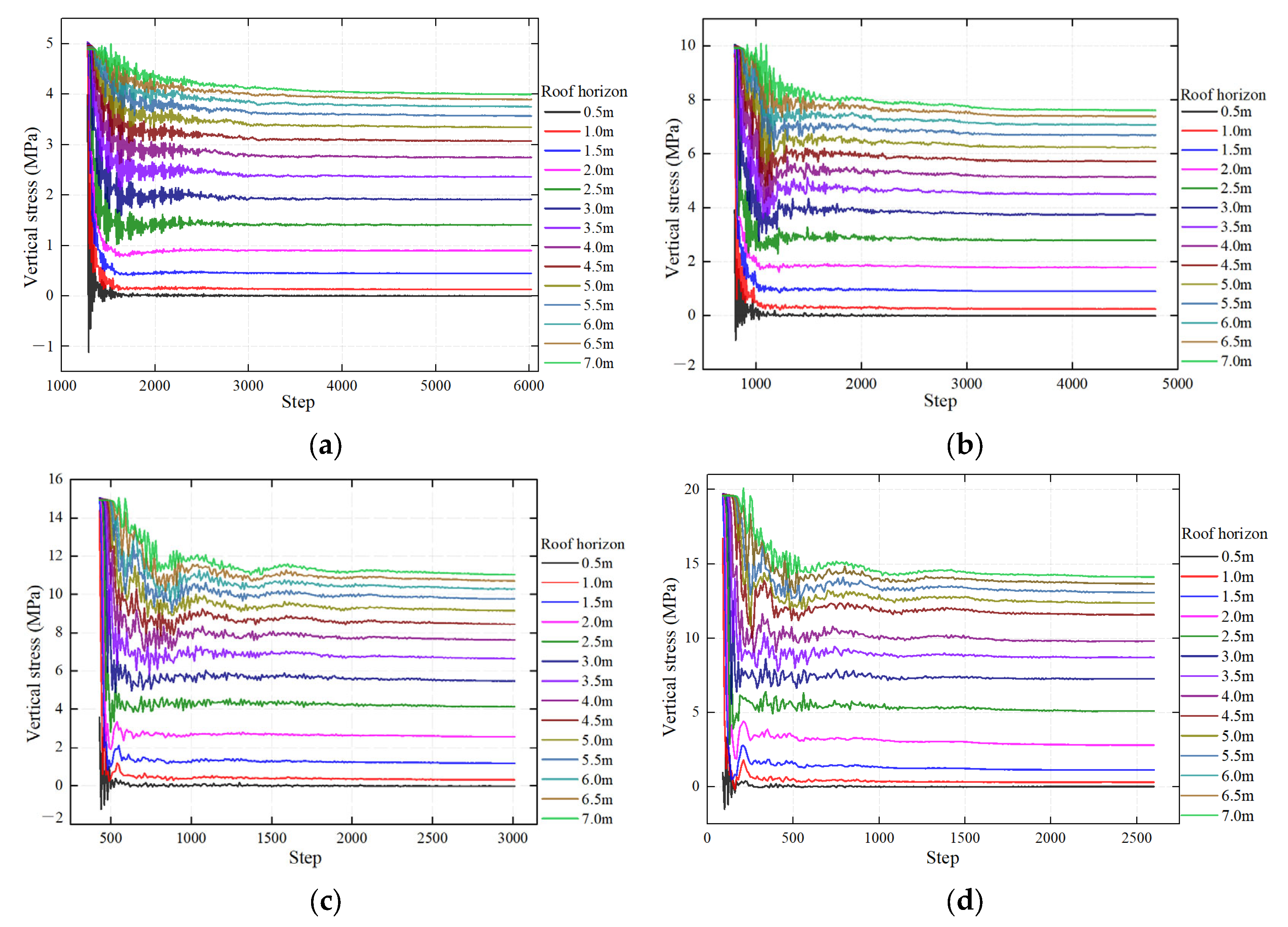

3.2.2. Displacement Distribution Law of Rock Mass in Different Roof Horizons
3.3. High Efficiency Bearing Characteristics of Bolt in Thick Anchorage Layer of Roof
4. Cross-Boundary Linkage Control Principle of Thick Anchorage Layer
5. Industrial Test
5.1. Cross-Boundary Linkage Control Supporting Scheme of the Thick Anchorage Layer
5.2. Effect Analysis
5.2.1. Surface Displacement of the Roadway
5.2.2. Monitoring of Fractures in the Roof Rock Stratum
5.2.3. Picture of Roadway Control Effect
6. Conclusions
- (1)
- The discontinuous deformation degree and expansion range of the roof of the deep roadway are significantly increased. The excavation of the roadway leads to the stress unloading of the rock mass at different shallow horizons of the roof, resulting in the deformation of the rock mass. The stress attenuation degree and deformation degree of the rock mass at different horizons of roof are different, resulting in discontinuous deformation of rock mass. The degree of discontinuous deformation tends to gradually decrease from the shallow to the deep part of the roof until the continuous deformation zone with small deformation and stable rock strata appears. With the increase in the roadway buried depth, the discontinuous deformation degree of roof and its extended range show an increasing trend.
- (2)
- Bolt support in the thick anchorage layer can effectively improve the bearing capacity of the support. In the same roadway roof, increasing the length of the bolts (the thickness of the anchorage layer) can anchor the end of the bolts in the continuous deformation zone with small deep deformation and stable rock mass. As the deformation difference of the rock mass within the anchorage range of the bolt increases, the load of the bolt can rapidly increase to limit the deformation of the shallow rock mass. When the length of bolt is increased to a certain range, the displacement difference of the rock mass within the anchorage range tends to be stable, and the working load tends to be stable as well.
- (3)
- The cross-boundary linkage control technology of the thick anchorage layer was put forward. The construction of the thick anchorage layer of the roof can make the bolt cross the potential discontinuous deformation zone of the shallow rock mass to reach the stable rock strata in the deep continuous deformation zone. In other words, this technology uses the small displacement of the stable rock mass in the deep continuous deformation zone to limit the large displacement of the rock mass with fracture damage in the shallow discontinuous deformation zone. The linkage between the large and small displacements of rock mass can control the progressive upward extension of the discontinuous deformation zone of the roof, that is, control the progressive damage failure of rock mass from shallow to deep.
- (4)
- The industrial test on cross-boundary linkage control of the thick anchorage layer of the deep buried roadway roof was carried out. The results show that the deformation control effect on the roadway-surrounding rock is good; the deformation value of the roof when stable is less than 12 mm, and the displacement of the two ribs is less than 16 mm. Moreover, the scope of the discontinuous deformation zone (separation fracture zone) of the roof is controlled at the shallow horizon of 0.85 m, and no separation fracture is found in the deep rock mass, which effectively limits the progressive upward extension of the discontinuous deformation zone of the roof.
Author Contributions
Funding
Data Availability Statement
Acknowledgments
Conflicts of Interest
Abbreviations
| ARR 21204 | air return roadway 21204 |
References
- Xie, H.P.; Ju, Y.; Ren, S.H.; Gao, F.; Liu, J.Z.; Zhu, Y. Theoretical and technological exploration of deep in situ fluidized coal mining. Front. Energy 2019, 13, 603–611. [Google Scholar] [CrossRef]
- Xie, H.P.; Gao, M.Z.; Zhang, R.; Peng, G.Y.; Wang, W.Y.; Li, A.Q. Study on the Mechanical Properties and Mechanical Response of Coal Mining at 1000m or Deeper. Rock Mech. Rock Eng. 2019, 52, 1475–1490. [Google Scholar] [CrossRef]
- Qi, Q.Q.; Pan, Y.S.; Li, H.T.; Jiang, D.Y.; Shu, L.Y.; Zhao, S.K.; Zhang, Y.J.; Pan, J.F.; Li, H.Y.; Pan, P.P. Theoretical basis and key technology of prevention and control of coal-rock dynamic disasters in deep coal mining. J. China Coal Soc. 2020, 45, 1567–1584. [Google Scholar]
- Chen, X.J.; Li, L.Y.; Wang, L.; Qi, L.L. The current situation and prevention and control countermeasures for typical dynamic disasters in kilometer-deep mines in China. Saf. Sci. 2019, 115, 229–236. [Google Scholar] [CrossRef]
- Zhan, Q.J.; Zheng, X.G.; Du, J.P.; Xiao, T. Coupling Instability Mechanism and Joint Control Technology of Soft-Rock Roadway with a Buried Depth of 1336 m. Rock Mech. Rock Eng. 2020, 53, 2233–2248. [Google Scholar] [CrossRef]
- Yang, H.Q.; Han, C.L.; Zhang, N.; Pan, D.J.; Xie, Z.Z. Research and Application of Low Density Roof Support Technology of Rapid Excavation for Coal Roadway. Geotech. Geol. Eng. 2020, 38, 389–401. [Google Scholar] [CrossRef]
- Mandal, P.K.; Das, A.J.; Kumar, N.; Bhattacharjee, R.; Tewari, S.; Kushwaha, A. Assessment of roof convergence during driving roadways in underground coal mines by continuous miner. Int. J. Rock Mech. Min. Sci. 2018, 108, 169–178. [Google Scholar] [CrossRef]
- Alejano, L.R.; Taboada, J.; Garcia-Bastante, F.; Rodriguez, P. Multi-approach back-analysis of a roof bed collapse in a mining room excavated in stratified rock. Int. J. Rock Mech. Min. Sci. 2008, 45, 899–913. [Google Scholar] [CrossRef]
- Hebblewhite, B.K.; Lu, T. Geomechanical behaviour of laminated, weak coal mine roof strata and the implications for a ground reinforcement strategy. Int. J. Rock Mech. Min. Sci. 2004, 41, 147–157. [Google Scholar] [CrossRef]
- Ma, N.J.; Zhao, X.D.; Zhao, Z.Q.; Li, J.; Guo, X.F. Stability analysis and control technology of mine roadway roof in deep mining. J. China Coal Soc. 2015, 40, 2287–2295. [Google Scholar]
- Li, J.; Peng, B.; Yuan, P. A formation mechanism of “low resistance and slight change” in plastic zone of butterfly leaf on the roof in deep roadway. J. Min. Saf. Eng. 2019, 36, 465–472. [Google Scholar]
- Yuan, Y.X.; Han, C.L.; Zhang, N.; Feng, X.W.; Wang, P.; Song, K.; Wei, M. Zonal Disintegration Characteristics of Roadway Roof Under Strong Mining Conditions and Mechanism of Thick Anchored and Trans-boundary Supporting. Rock Mech. Rock Eng. 2022, 55, 297–315. [Google Scholar] [CrossRef]
- Mazurek, K.; Szygula, M.; Figiel, A.; Filipowicz, K. Continuous Support for Roadways. Energies 2021, 14, 5801. [Google Scholar] [CrossRef]
- Zuo, J.P.; Wen, J.H.; Hu, S.Y.; Zhao, S.K. Theoretical model and simulation study of uniform strength beam support in deep coal mine roadway. J. China Coal Soc. 2018, 43, 1–11. [Google Scholar]
- Zuo, J.P.; Wen, J.H.; Liu, D.J.; Wu, L.L.; Sun, Y.J. Control theory of uniform strength support in deep roadway. J. Min. Sci. Technol. 2021, 6, 148–159. [Google Scholar]
- Kang, H.P.; Li, J.Z.; Yang, J.H.; Gao, F.Q. Investigation on the Influence of Abutment Pressure on the Stability of Rock Bolt Reinforced Roof Strata Through Physical and Numerical Modeling. Rock Mech. Rock Eng. 2017, 50, 387–401. [Google Scholar] [CrossRef]
- Colwell, M.; Frith, R. Utilising the scientific method to demonstrate that slender beam/column behaviour is the dominant behavioural mechanism leading to roof/rib failure. Int. J. Min. Sci. Technol. 2021, 31, 867–887. [Google Scholar] [CrossRef]
- Xie, Z.Z.; Zhang, N.; Yuan, Y.X.; Xu, G.; Wei, Q. Study on Safety Control of Composite Roof in Deep Roadway Based on Energy Balance Theory. Sustainability 2019, 11, 3688. [Google Scholar] [CrossRef] [Green Version]
- An, Y.P.; Zhang, N.; Zhao, Y.M.; Xie, Z.Z. Field and numerical investigation on roof failure and fracture control of thick coal seam roadway. Eng. Fail. Anal. 2021, 128, 105594. [Google Scholar] [CrossRef]
- Jia, P.; Zhu, W.; Zhang, S. Effect of heterogeneity on occurrence of zonal disintegration around deep underground openings. Int. J. Min. Sci. Technol. 2014, 24, 859–864. [Google Scholar] [CrossRef]
- Wu, H.; Guo, Z.; Fang, Q.; Zhang, Y.; Liu, J. Mechanism of zonal disintegration phenomenon in enclosing rock mass around deep tunnels. J. Cent. South Univ. Technol. Engl. Ed. 2009, 16, 303–311. [Google Scholar] [CrossRef]
- Wu, Q.S.; Jiang, L.S.; Wu, Q.L.; Xue, Y.C.; Gong, B. A study on the law of overlying strata migration and separation space evolution under hard and thick strata in underground coal mining by similar simulation. Dyna 2018, 93, 175–181. [Google Scholar] [CrossRef] [PubMed] [Green Version]
- Tan, Y.L.; Zhao, T.B.; Xiao, Y.X. Researches on floor stratum fracturing induced by antiprocedure mining underneath close-distance goaf. J. Min. Sci. 2010, 46, 250–259. [Google Scholar] [CrossRef]
- Jiang, Z.W.; Wang, Q.Y. Risk Assessment on Ground Fissure Disasters of Xi’an Metro Line 3. Adv. Mater. Res. 2011, 255–260, 3841. [Google Scholar] [CrossRef]
- Yang, H.Q.; Han, C.L.; Zhang, N.; Sun, Y.T.; Pan, D.J.; Sun, C.L. Long High-Performance Sustainable Bolt Technology for the Deep Coal Roadway Roof: A Case Study. Sustainability 2020, 12, 1375. [Google Scholar] [CrossRef] [Green Version]
- Zhang, N.; Han, C.L.; Xie, Z.Z. Theory of continuous beam control and high efficiency supporting technology in coal roadway. J. Min. Strat. Control Eng. 2019, 1, 48–55. [Google Scholar]
- Xie, Z.Z.; Zhang, N.; Feng, X.W.; Liang, D.X.; Wei, Q.; Weng, M.Y. Investigation on the evolution and control of surrounding rock fracture under different supporting conditions in deep roadway during excavation period. Int. J. Rock Mech. Min. Sci. 2019, 123, 104122. [Google Scholar] [CrossRef]
- Yang, H. Experimental Study on Mechanical Properties of Fully Bonded Bolts with Varied Bond Length. Geotech. Geol. Eng. 2022, 40, 4083–4094. [Google Scholar] [CrossRef]
- Xie, Z.; Zhang, N.; Han, C.; An, Y. Research on principle and application of roof thick layer cross-boundary anchorage in coal roadways. Yanshilixue Yu Gongcheng Xuebao/Chin. J. Rock Mech. Eng. 2021, 40, 1195–1208. [Google Scholar] [CrossRef]



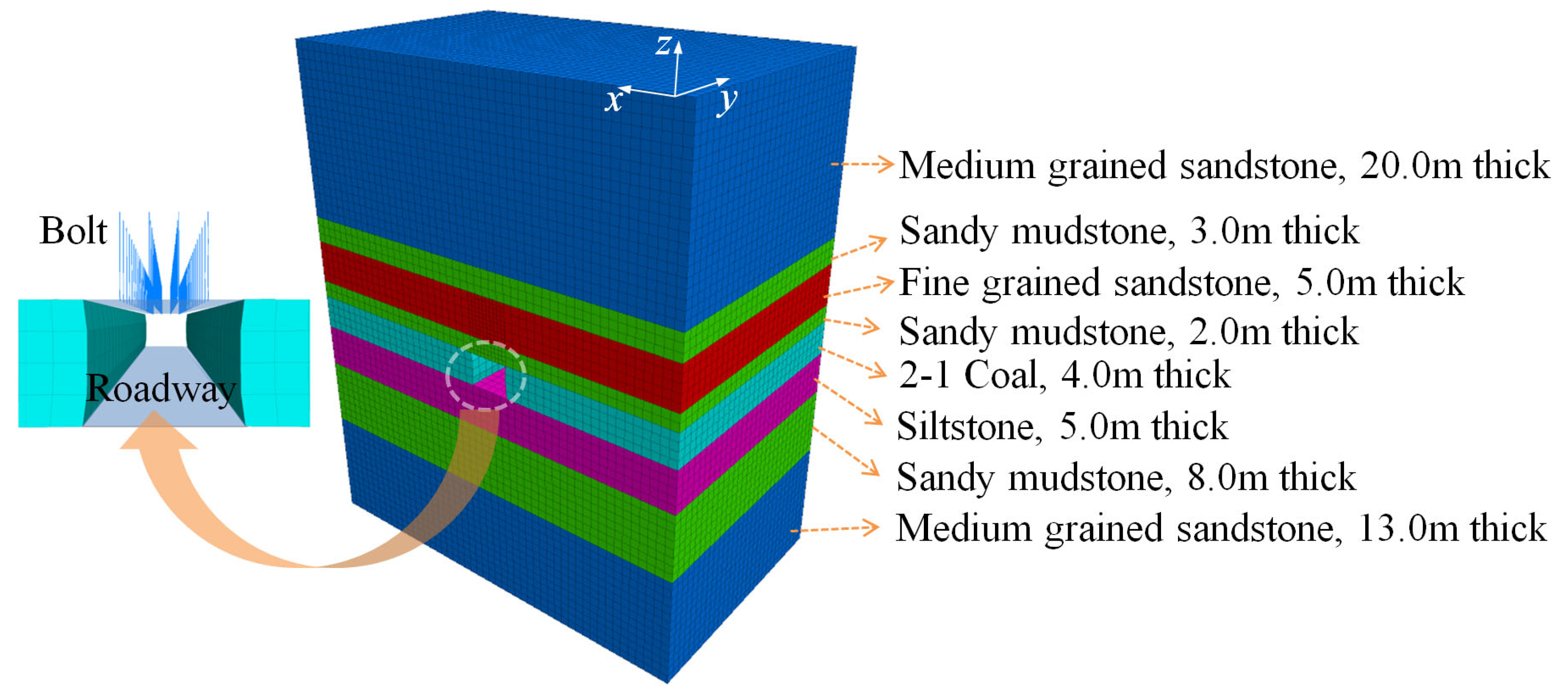
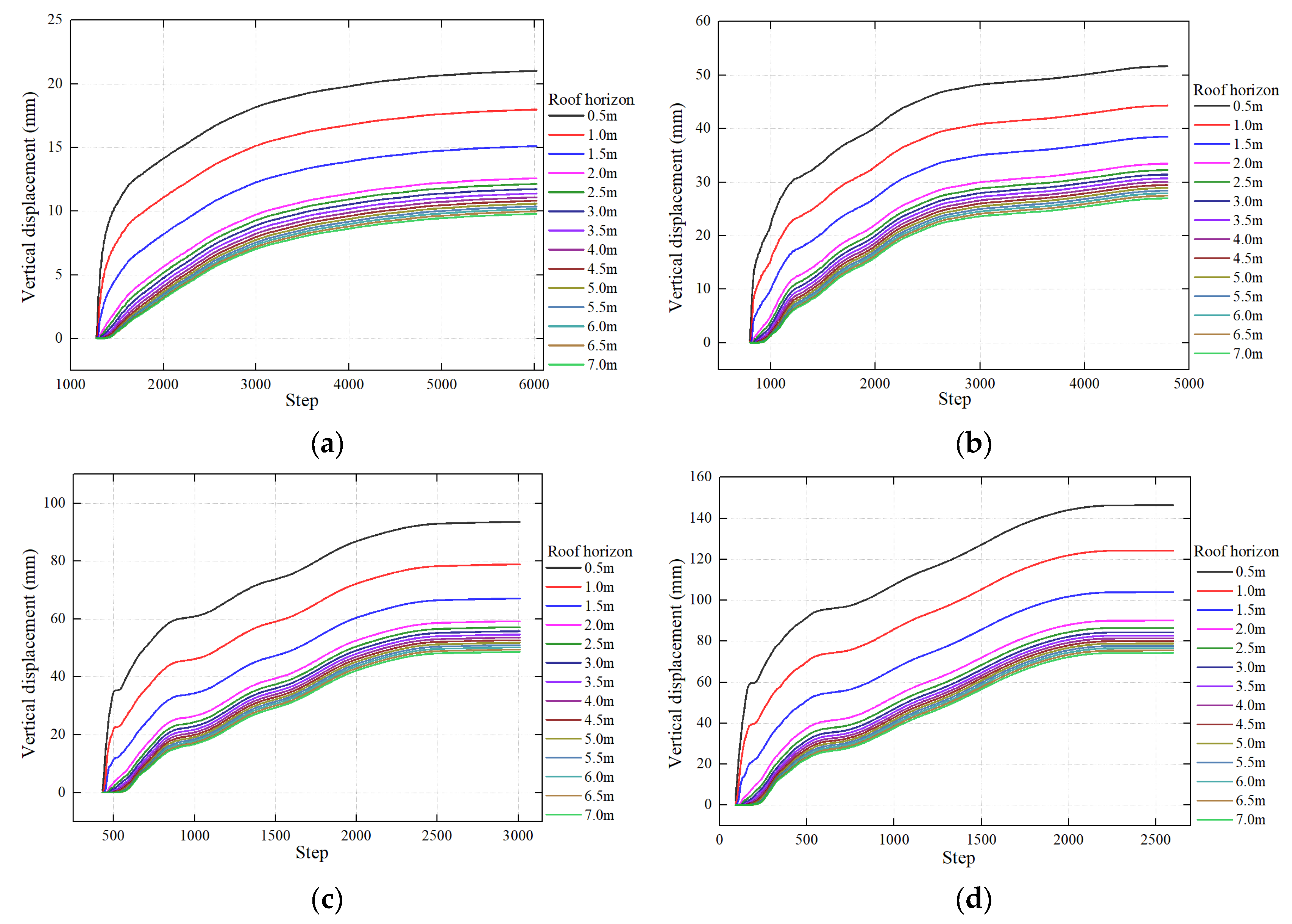

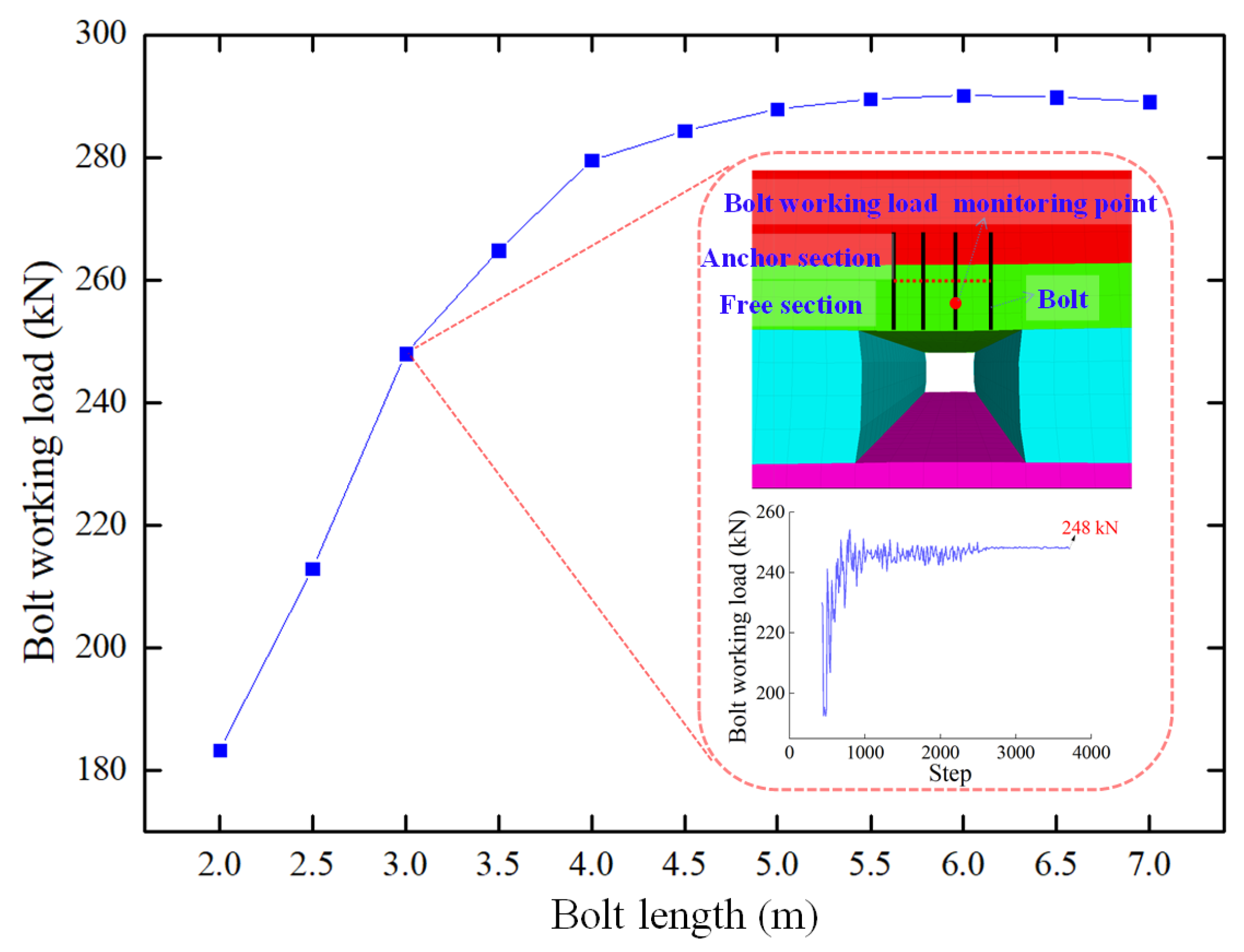


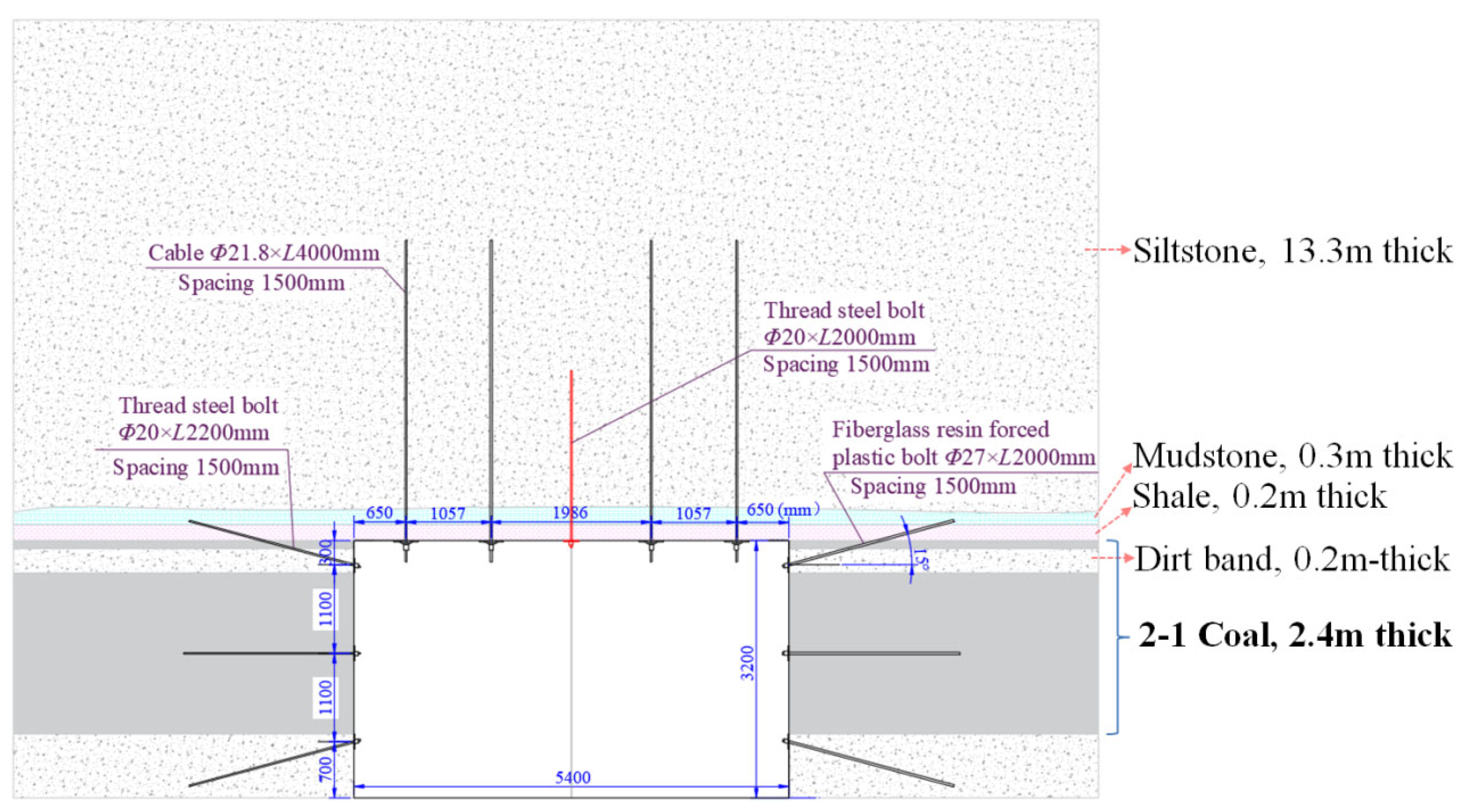



| Number | Lithology | Thickness (m) | Density (kg·m−3) | Bulk Modulus (GPa) | Shear Modulus (GPa) | Internal Friction Angle (°) | Cohesion (MPa) | Tensile Strength (MPa) |
|---|---|---|---|---|---|---|---|---|
| 4 | Medium grained sandstone | 20.0 | 2598 | 3.5 | 1.8 | 30.0 | 1.3 | 1.6 |
| 3 | Sandy mudstone | 3.0 | 2400 | 4.6 | 3.2 | 35.0 | 2.0 | 2.5 |
| 2 | Slight grained sandstone | 5.0 | 2635 | 3.0 | 1.6 | 28.0 | 1.5 | 1.5 |
| 1 | Sandy mudstone | 2.0 | 2400 | 4.6 | 3.3 | 35.0 | 2.0 | 2.5 |
| 0 | 3-1 Coal | 4.0 | 1291 | 1.3 | 0.3 | 25.0 | 1.1 | 0.5 |
| −1 | Siltstone | 5.0 | 2567 | 3.0 | 1.6 | 28.0 | 1.5 | 3.9 |
| −2 | Sandy mudstone | 8.0 | 2400 | 4.6 | 3.2 | 35.0 | 2.0 | 2.5 |
| −3 | Medium grained sandstone | 13.0 | 2598 | 3.5 | 1.8 | 30.0 | 1.3 | 1.6 |
Disclaimer/Publisher’s Note: The statements, opinions and data contained in all publications are solely those of the individual author(s) and contributor(s) and not of MDPI and/or the editor(s). MDPI and/or the editor(s) disclaim responsibility for any injury to people or property resulting from any ideas, methods, instructions or products referred to in the content. |
© 2023 by the authors. Licensee MDPI, Basel, Switzerland. This article is an open access article distributed under the terms and conditions of the Creative Commons Attribution (CC BY) license (https://creativecommons.org/licenses/by/4.0/).
Share and Cite
Han, C.; Zhang, N.; Yang, H.; Zhao, Q.; Song, K. Discontinuous Deformation Characteristics of Deep Buried Roadway Roofs and Linkage Control of Thick Layer Cross-Boundary Anchorage: A Case Study. Energies 2023, 16, 2160. https://doi.org/10.3390/en16052160
Han C, Zhang N, Yang H, Zhao Q, Song K. Discontinuous Deformation Characteristics of Deep Buried Roadway Roofs and Linkage Control of Thick Layer Cross-Boundary Anchorage: A Case Study. Energies. 2023; 16(5):2160. https://doi.org/10.3390/en16052160
Chicago/Turabian StyleHan, Changliang, Nong Zhang, Houqiang Yang, Qifeng Zhao, and Kai Song. 2023. "Discontinuous Deformation Characteristics of Deep Buried Roadway Roofs and Linkage Control of Thick Layer Cross-Boundary Anchorage: A Case Study" Energies 16, no. 5: 2160. https://doi.org/10.3390/en16052160






